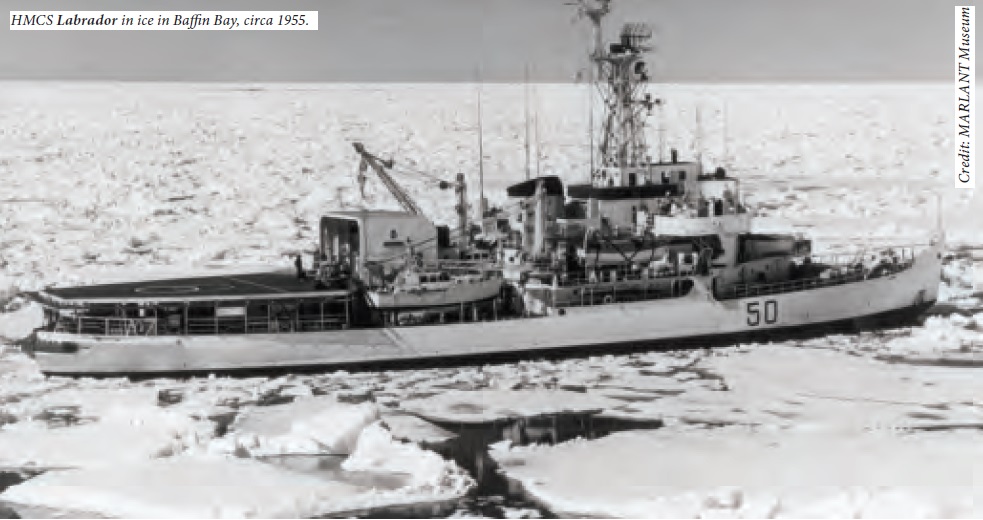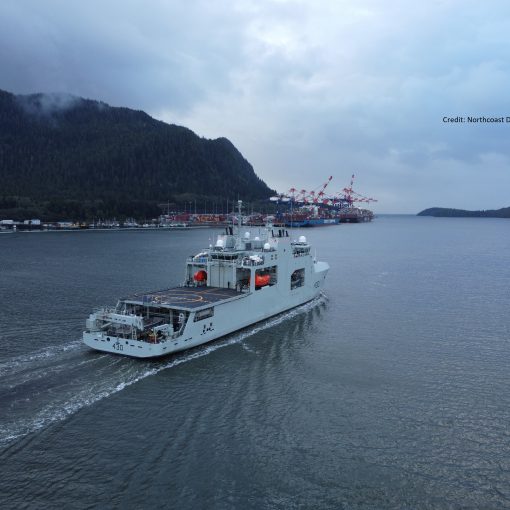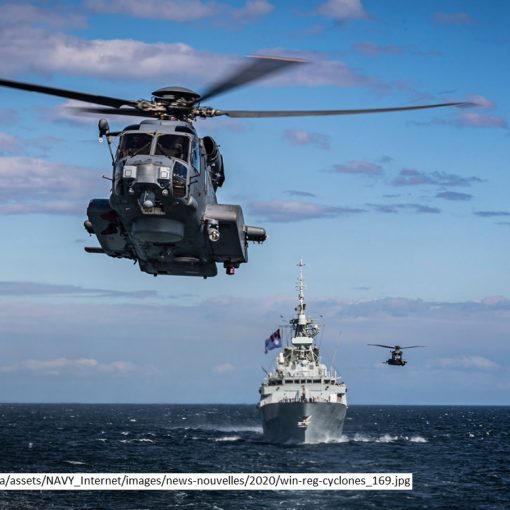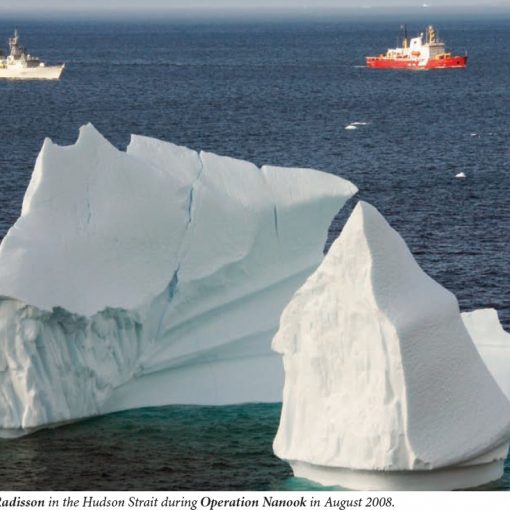This Arctic, this Canadian Arctic is our business – ours to exploit, ours to defend.
Commodore O.C.S. Robertson, RCN
Astonishingly, the numerous deployments by the ships of the Royal Canadian Navy into the Canadian North have never been tabulated. Because of this, it is not known precisely how many ships went North, when they did so, and where they went. In recent years, with individual RCN ships proudly proclaiming “farthest North status” during the now regular NORPLOYs, the RCN Command Historian, Dr Richard Gimblett and Michael Whitby, Senior Naval Historian at the Directorate of History and Heritage, discussed the need for a basic chronology of Canadian naval deployments into the North. The idea languished until the autumn of 2014 when Rear-Admiral John Newton, Commander MARLANT and a passionate veteran of Arctic operations, lit the fuse that got this particular northern research expedition under way.
Much has been written about the RCN’s forays into the North, especially in recent years when the operations have taken on increased importance for environmental, political and strategic reasons. However, when analysts and historians have attempted to lay out the RCN’s missions into the North, the material is sometimes fraught with inaccuracies and oversights - not the fault of the various authors since the precise facts were unknown or sometimes shrouded in secrecy. This survey attempts to rectify that situation. It is based upon research of primary sources, including naval messages, operational schedules, reports of proceedings, ship’s movement data, Annual Historical Reports and other such documents. In support of that effort, sailors who went North on the various missions have provided important research lead marks. It must be understood, this compendium is only meant to provide the bare bones of ‘what’, ‘where’ and ‘when’ concerning these deployments; the next and more important step is to continue to pose the important questions ‘how’, ‘why’ and ‘so what’ in regard to the RCN’s experience in the Canadian North.
Some parameters behind the list require explanation. Most important, ‘North’ has been defined as any deployment beyond Lilliniq Island at the southern entrance of Hudson Strait in the east, and past the Diomede Islands in the Bering Strait in the west. Although MARPAC designated some deployments as ‘NORPLOYs’ in the mid-1970s, these took place along the southern coast of Alaska, and, as with the numerous operations along the coast of northern Labrador, have not been included. Similarly, several planned deployments that were cancelled for various reasons have not been listed. The survey only traces deployments by ships, and so does not include critical work such as that done by the navy clearance divers who worked on the Distant Early Warning (DEW) Line and other projects, and the communications personnel who manned naval radio detachments. Likewise, the exploits of individual sailors who played a pioneering role in expanding the navy’s knowledge of the North - such as Commander C.T. Beard who accompanied the government’s 1935 Arctic Patrol, Commodore O.C.S. Robertson who travelled the region in a USN icebreaker, blimp and two nuclear submarines, and Commander J.P. Croal, the naval staff’s resident Arctic expert into the 1960s - have not been included. The survey also does not incorporate the many Canadian Coast Guard vessels and CNAVs that routinely supported and acted as research partners to the RCN deployments. Finally, the survey only covers operations in the Canadian North, and thus excludes the many warships that ventured beyond the Arctic Circle in the Eastern Atlantic during the Second World War and the Cold War.
The survey is comprised of four sections. The first details the various deployments, including their date, a basic description of their purpose and some of the locations visited during the operation—the goal is not to provide a history of the deployments, just to outline the basic information. The second section names the ships that have steamed the farthest into the High Arctic. The third and fourth sections break down the deployments by ship type and by individual ship: the former conveys that almost all of the types used by our navy—from Second World War destroyers to modern frigates, aircraft carriers to minesweepers; AORs to submarines - have ventured into the North at one time or another; the latter, which totals 42 ships, shows that many, many sailors went with them.
As a final point, the authors see this as a ‘living document’ and recognize that it may contain omissions and inaccuracies. They humbly request that any veterans, analysts, historians or students of the North who have knowledge of other naval deployments to the North or comments about those listed, please inform Michael Whitby at Michael.whitby@forces.gc.ca so that the list can be amended to make it as definitive as possible. The resultant product and supporting research will be deposited into the archives of the Directorate of History and Heritage, National Defence Headquarters, Ottawa.
SECTION ONE
Deployments
1949 – HMCS CEDARWOOD
- Western Arctic: July-August
- Chukchi Sea - proceeded as far north as latitude 73˚ 15’ North
- Part of the Joint Canadian-American Aleutian Scientific Expedition investigating, among other things, the challenges associated with operating submarines in the Arctic – in company with submarine USS BAYA and other vessels
1948 – HMCS MAGNIFICENT, HAIDA and NOOTKA
- Hudson Bay cruise: 2-28 September
- MAGNIFICENT proceeded as far as Hudson Strait; NOOTKA and HAIDA continued into Hudson Bay to visit Wakeham Bay, Churchill and Coral Harbour
- The RN was asked to provide a submarine for this and SWANSEA’s 1949 deployment but demurred
1949 – HMCS SWANSEA
- 25 August-15 September
- Frobisher Bay, Koojessin Inlet and Nuuk (formally Godthaab), Greenland
- Familiarization with Arctic conditions and scientific research
1954 – HMCS LABRADOR
- July-November
- Resolute, Craig Harbour, Alexandra
- north of Arctic Circle from 28 July-20 September (55 days)
- transited Northwest Passage and completed first circumnavigation of North America
1955 – HMCS LABRADOR
- July-November
- Supporting construction of DEW Line in Eastern Arctic
- Foxe Basin, off Baffin Island
1956 – HMCS LABRADOR
- July-October
- Supporting construction of DEW Line in Eastern Arctic
- Bellot Strait
1957 – HMCS LABRADOR
- June-October
- Supporting construction of DEW Line in Eastern Arctic
- transited Bellot Strait
- recovered the anchors of HMS FURY from Franklin Expedition
1961 – HMCS CAP DE LA MADELEINE
- August-September
- Frobisher Bay - to erect a communications facility on southern Baffin Island
1961 – HMCS BONAVENTURE, RESTIGOUCHE, ST CROIX, HAIDA, ALGONQUIN, HURON, HMS AUROCHS and USS NEOSHO
- EX TRAPLINE: 2-8 October
- Entrance to Hudson Strait and Ungava Bay - ASW exercise
- AUROCHS was from 6th Submarine Squadron on loan to RCN, while USS NEOSHO was a fleet oiler lent to the RCN for this operation
1962 - HMCS LA HULLOISE, BUCKINGHAM, LAUZON and SWANSEA
- August-September
- Transited Hudson Strait for port visits to Churchill and Port Harrison
- UNTD cruise
1970 – HMCS PROTECTEUR, SKEENA, ANNAPOLIS, FRASER, TERRA NOVA, OJIBWA and OKANAGAN
- NORPLOY: 28 July-31 August
- Carried out in two stages: first, was a series of port visits in Hudson Bay/Hudson Strait area; second, was MARCOT 2/70 , a six-day A/S exercise in Frobisher Bay and Labrador Sea
- PROTECTEUR put into Churchill, Rankin Inlet, Coral Harbour and Frobisher
- ANNAPOLIS put into Frobisher Bay, Rankin Inlet, Coral Harbour
- SKEENA put into Churchill, Rankin Inlet, Chesterfield Inlet and Wakeham Bay
- FRASER, TERRA NOVA, OJIBWA and OKANAGAN deployed only for MARCOT 2/70
1971 – HMCS PRESERVER, MARGAREE and ASSINIBOINE
- August-September
- Frobisher Bay, and Nuuk, Greenland
1972 – HMCS PROTECTEUR, YUKON, ST LAURENT, FRASER and ONONDAGA
- NORPLOY: 1-17 August
- Lower Davis Strait and Hudson Strait – exercising A/S capability in northern waters
- FRASER put into Lake Harbour and Wakeham; ST LAURENT, Koartac; and YUKON did port visit to Nuuk, Greenland
- Intent was for ONONDAGA to head into upper Davis Strait but larger than expected ice concentrations limited her to lower Davis Strait and Hudson Strait
1973 - HMCS PROTECTEUR
- NORPLOY: August-September
- Pond Inlet, Mackinson Inlet, Grise Fjord, Resolute Bay, Beechy Island and Iqaluit
1974– HMCS PRESERVER, SAGUENAY and ASSINIBOINE
- NORPLOY: 6-29 August
- Hudson Strait/Hudson Bay
- SAGUENAY operated independently and visited St Anthony, Chesterfield Inlet, Rankin Inlet and Churchill
- ASSINIBOINE: Eskimo Point, Churchill, Frobisher Bay and Resolution Island
1975 – HMCS PROTECTEUR
- NORPLOY: 6 August-18 September
- Port Burwell, Lake Harbour, Wakeham Bay, Cape Dorset, Povungnituk, Iruijivik, Sugluk, Arctic Bay and Resolute
- Replenishing “303 Ball Ammunition” for Canadian Rangers - scientific research
1977 – HMCS PRESERVER, OTTAWA and ASSINIBOINE
- NORPLOY: 1 August-9 September
- Hudson Strait, southern shore of Baffin Is, Eskimo Point, Pritzler Harbour, Lake Harbour, Cape Dorset, Lancaster Sound, Resolute Bay, Barrow Strait
- Scientific study and logistical support to PPCLI during Ex NORTHERN VIKING
1978 – HMCS PROTECTEUR
- OP BOXSTOP II: 13 July-4 August
- Sealifting 1100 tons of stores from Montréal to Thule, Greenland, for onward transit to CFB ALERT
1979 – HMCS PRESERVER
- NORPLOY: 3-24 August
- Lancaster Sound to Radstock Bay
- Forced to terminate operation early due to deteriorating ice conditions and engineering problems
- CORMORANT was scheduled to accompany NORPLOY but forced to cancel due to engineering problems; gear and personnel transferred to PRESERVER
1982 – cancelled
- CORMORANT sailed for an Arctic deployment in August but forced to abandon that part of the operation due to engineering problems and instead conducted a CANLANT patrol off Labrador
- PROTECTEUR also assigned to conduct a NORPLOY but had to cancel due to lack of availability of helicopters
1986 – HMCS CORMORANT
- NORPLOY
- Northern reaches of Lancaster Sound, Clyde River, Nanisivik, Arctic Bay, Pond Inlet
- Each of CORMORANT’s three northern deployments were supported by CNAV QUEST
1987 – HMCS OKANAGAN
- Operational Surveillance Patrol: 14 September-2 October
- Hudson Strait
1988 – HMCS CORMORANT
- NORPLOY: 3 August-13 September
- Iqaluit, Pond Inlet, Bylot Island, Nuuk (Greenland)
- Acoustic research along edge of and into ice pack
1989 – HMCS CORMORANT
- NORPLOY: 21 August-5 October
- Lancaster Sound, Grise Fjord and Nanisivik
- Military ops and scientific research – ice punched a hole in CORMORANT’s hull
1989 - PRESERVER, ANNAPOLIS and FRASER
- EX ICE EDGE - to exercise ASW against SSN in ice conditions – USS STURGEON (SSN-637) provided the opposition
- near the edge of the polar ice in Davis Strait
2002 – HMCS GOOSE BAY and SUMMERSIDE
- NORPLOY: 22 July-15 August
- Kimmirut, Iqaluit and Resolution Island
- the inaugural OP NARWHAL exercise with JTF North
2004 – HMCS MONTRÉAL and GOOSE BAY
- EX NARWHAL: August
- MONTRÉAL: Iqaluit, Pangnirtung Fjord, Cumberland Sound
- GOOSE BAY first MCDV to cross Arctic Circle (29 Aug); re-crossed with MONTRÉAL on 30 August
2005 – HMCS FREDERICTON, GLACE BAY and SHAWINIGAN
- August-September
- FREDERICTON deployed as a contingency fuel resupply asset for two MCDVs and conducted an Arctic FISHPAT in Davis Strait
- Nuuk, Greenland, Clyde River, Pond Inlet, Iqaluit– reached 74˚ 19’ North, which Annual Historical Report says was “highest latitude for a CPF”
- GLACE BAY and SHAWINIGAN on EX HUDSON SENTINEL in Hudson Bay
- SHAWINIGAN: Arviat Harbour, Rankin Inlet, Coral Harbour and Cape Dorset
- GLACE BAY: Whale Cove, Rankin Inlet and Chesterfield Inlet
2006 – HMCS MONTRÉAL, GOOSE BAY and MONCTON
- OP LANCASTER: 12-25 August – “patrol of Arctic waters”
- MONTRÉAL: Nuuk, Greenland, Iqaluit, Pond Inlet
- MONCTON: Iqaluit, Dundas Harbour, Pond Inlet
- MONCTON reached 76˚ 31.4381’ North, “…entered now in the Historical Report as the furthest north of any vessel currently in service with the Navy”
2007 – HMCS CORNER BROOK, FREDERICTON and SUMMERSIDE
- OP NANOOK: August
- Iqaluit
- FREDERICTON and SUMMERSIDE conducted boarding exercises, and A/S serials with CORNER BROOK
- FREDERICTON last minute replacement for TORONTO due to engineering problems
2008 - HMCS TORONTO and SHAWINIGAN
- OP NANOOK: August
- Frobisher Bay
2009 - HMCS TORONTO and CORNER BROOK
- OP NANOOK: August
- Davis Strait, Frobisher Bay
- Amphibious exercise with CCGS PIERRE RADISSON; A/S exercise
- GLACE BAY sailed for NORPLOY but forced to abandon deployment before reaching northern waters due to engineering problems
2010 - HMCS MONTRÉAL and GOOSE BAY
- OP NANOOK: 3 August-2 September
- MONTRÉAL: Groenedale and Nuuk Greenland, Nanisivik and Grise Fjord (AHR says furthest North of any CPF)
- GOOSE BAY: Iqaluit, Pond Inlet and Nanisivik – in company with USCG ALDER, later joined by HMDS KNUD RASMUSSEN
2011 - HMCS SUMMERSIDE
- OP NANOOK: August
- Iqaluit, LAV site on Baffin Is, Qikiqtarjuaq
- Accompanied by USCG WILLOW
- Conducted a FISHPAT off Frobisher Bay
- Did ‘Relief-in-Place’ with crew of GOOSE BAY
2012 – HMCS ST JOHN’S
- OP NANOOK: 7-31 August
- Nuuk, Greenland, Cape Dorset, Churchill, Frobisher Bay
- Exercises with HDMS TRITON
2013 – HMCS SHAWINIGAN and SUMMERSIDE
- OP NANOOK
- SUMMERSIDE conducted hydrographic surveys for Canadian Hydrographic Services (CHS), charting and surveying for deep sea shipping at Milne Inlet in preparation of mine shipments out of Mary River
2014 – HMCS KINGSTON and SHAWINIGAN
- Op NANOOK, Op QIMMIQ
- Iqaluit, Erik Harbour
- SHAWINIGAN reached latitude of 80˚ 28’ N. – this has been recognized as the furthest north by any Canadian warship. She also did a SAR scenario with HDMS TRITON and HMDS KNUD RASMUSSEN
- KINGSTON was assigned to the Victoria Strait search for the lost ships of the Franklin Expedition but pack ice prevented her transit to the search site. She instead executed hydrographic surveys on behalf of CHS in Milne Inlet and Eclipse Sound
SECTION TWO
Farthest North: (Not yet verified through log books)
- 2014—HMCS SHAWINIGAN reached 80˚ 28’ North
- 1954—HMCS LABRADOR reached 79˚ 58’ North
- 2006—HMCS MONCTON reached 76˚ 31.4381’ North
SECTION THREE
Deployments by type:
AGSC – 1
AOR - 10
ASL - 3
AW - 4
CPF - 8
CVL - 2
DD - 5
DDE - 4
DDH - 13
FFH - 7
MCDV - 16
SSK - 6
SECTION FOUR
Deployments by individual ships:
PRESERVER – 5
PROTECTEUR – 5
GOOSE BAY – 4
LABRADOR – 4
SHAWINIGAN – 4
SUMMERSIDE – 4
ASSINIBOINE – 3
CORMORANT – 3
FRASER – 3
MONTRÉAL – 3
ANNAPOLIS – 2
CORNER BROOK – 2
FREDERICTON – 2
HAIDA – 2
OKANAGAN – 2
SWANSEA – 2
TORONTO – 2
ALGONQUIN (DDE) – 1
BONAVENTURE – 1
BUCKINGHAM – 1
CAP DE LA MADELEINE – 1
CEDARWOOD – 1
GLACE BAY – 1
HURON (DE) – 1
KINGSTON – 1
LA HULLOISE – 1
LAUZON – 1
MAGNIFICENT – 1
MARGAREE – 1
MONCTON – 1
NOOTKA – 1
OJIBWA – 1
ONONDAGA – 1
OTTAWA (DDE) – 1
RESTIGOUCHE – 1
SAGUENAY – 1
SKEENA – 1
ST CROIX – 1
ST JOHN’S – 1
ST LAURENT – 1
TERRA NOVA – 1
YUKON – 1





